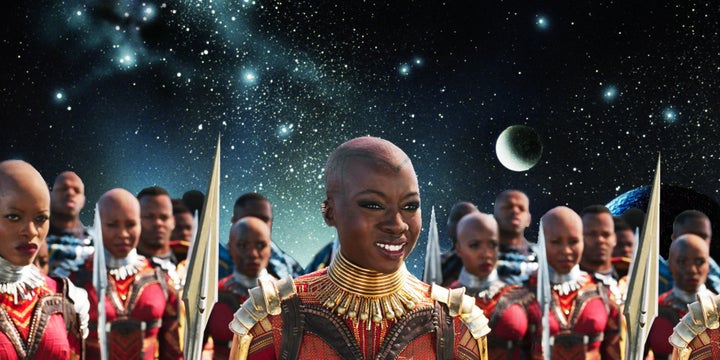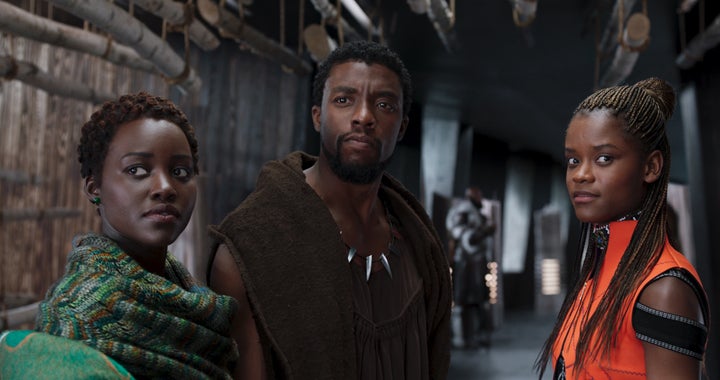Dr. Huey P. Newton said, "Marvin X was my teacher, many of our comrades came through his black arts theatre, e.g.Bobby Seale, BPP co-founder, Emory Douglas, Minister of Culture, Samuel Napier, Minister of Distribution of the Black Panther Newspaper and Eldridge Cleaver, Minister of Information, et al." See Marvin X's play of his last meeting with Huey Newton in a West Oakland Crack House, entitled Salaam, Huey Newton, Salaam, a scene from the full length docu-drama by Marvin X, One Day in the Life, produced in the Bay Area by Marvin's Recovery Theatre and in New York at Woody King's Federal Theatre. On the east coast the full length drama was performed at Sista's Place, Brooklyn, NY, Brecht Forum, Manhattan, and at Amiri Baraka's Kimako's Place, Newark, NJ.
If the film Black Panther is the neo-Roots, no matter if we saw Kunta reduced to Toby and we now enjoy Panther as a much needed Balm in Gilead to return Toby to Kunta in the process of reverse psycho-sociology for the culturally starved Pan African nation, and most especially North American Africans in the belly of the Beast, then let us enjoy this moment of make believe Hollywood fantasy, for we need any means necessary to regain our mental equilibrium, as our most revered sociologist and clinical psychologist, Dr. Nathan Hare, father of Black Studies and Ethnic Studies, teaches us.
FYI, Dr. Nathan Hare was the first chair of Black Studies on a major American university campus at San Francisco State College, now University, 1968. The student struggle to establish black and ethnic studies caused the longest and most violent student struggle in US academic history. Well, unlike the Kent State struggle, no students were murdered, but at SFSU, students were beaten down by SFPD on horses, many jailed and in imprisoned in the Third World Strike.
As an undergrad at SFSU, we are honored to have been a student when the Negro Students Association, 1964, suffered an internal struggle to become the Black Student Union and forced SFSU to establish black and ethnic studies with the mission to serve the community. A key move was simply demanding equity of funds from the Associated Students budget.
For sure, the student struggle at SFSU was not to create a class of tenured nigguhs who are equal in psycho pathology with the Hollywood fantasy Panther, especially in their pursuit of what Dr. Nathan Hare calls the Kingdom of Africana, that mythical place that is the cause of Harold Cruse's Crisis of the Negro Intellectual that yet perpetuates the world of make believe we inhabit (Dr. E. Franklin Frazier, Black Bourgeoisie, 1962) and conspicuous consumption.
Dr. Nathan Hare followed Frazier, yes, at Howard University, with his sociological classic Black Anglo-Saxons. From a Pan African perspective, we can understand how Black Studies morphed into the Kingdom of Africana with knowledge of how the African colonial elite became the administrators and educators of the newly independent African nations, along with our similar understanding of neo-slaves uplifted throughout the Third World. These newly independent nations threw off the chains of colonialism only to suffer neo-colonialism. Kwame Nkrumah said, "Neo-colonialism is colonialism playing possum!"
Again, nothing since Roots has jolted the psyche of culturally starved North American Africans and Africans throughout the Diaspora. The tragic reality is that neither Roots nor the current Panther film will ultimately assuage the very real Liberation of North American Africans and Africans throughout the Diaspora, especially those followers of Kwame Nkrumah and Kwame Toure' who called for the United States of Africa.
But let us consider what we can learn from Panther that will usher us into so-called Afrofuturism, the idea of a future world based on African mythology and a scientific vision of the future. The Black Arts Movement genius, musician, philosopher, poet Sun Ra must be the root of any serious discussion of Afrofuturism that is the foundation of deep structure Panther ideology. Alas, not only does Sun Ra's mythology inform the film but the real life Black Panther Party. Sun Ra gave a conscious return to our Kemetic mythology, yet extended the myth with his explorations into outer space with his music and theatrical productions that combined Kemetic or Egyptian mythology with an equal mythological narrative of us as space beings. See his classic film Space is the Place filmed in Oakland.
Sun Ra's Kemetic and Space myth brought an original mythology to the North American African historical and literary narrative. His Black Arts Movement associate, Amiri Baraka, approached his effort with his utilization of the Nation of Islam's Myth of Yacob, the mad scientist who created the devil white man through genetic engineering. I added to the BAM's mythological imagination with my myth-ritual dance drama Resurrection of the Dead, Black Educational Theatre, San Francisco, 1972.
Resurrection of the Dead, in BAM ritual theatre tradition, transcended drama when the "actors" took holy names in the naming ceremony and kept their names for life! Lead singer/actor Victor Willis will tell you it was the energy gained from Resurrection of the Dead that made him successful when he got to New York and ultimately become lead singer of the Village People.
If Panther wakes up the long dormant consciousness of Pan Africans, it will have done a masterful job in spite of its fantastical creation.
Finally, there are those critics who seriously questions the very idea of African royalty since the historical record is clear the African upper class was crucial in the Triangular Trade. Dr. Walter Rodney has delineated the fundamental role of kings and queens in the sale of our people to the Europeans, Arabs as well. Rodney notes how all African social institutions were corrupted to satisfy the greed of African kings and queens: the religious, judicial, military, political, economic institutions conspired to send us into that longs day journey into night. Thus, from slavery to the now, we must question socalled African royalty and most importantly those corrupt kings and queens for life known as politicians, many of whom yet rule African nations, alas, with wealth derived from the slave trade.
--Marvin X
2/17/18











